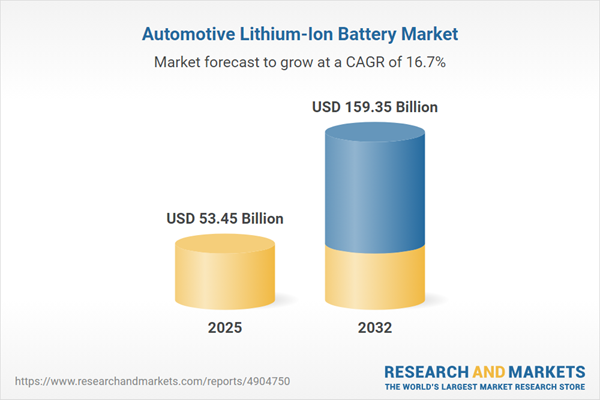Speak directly to the analyst to clarify any post sales queries you may have.
The automotive lithium-ion battery market is rapidly evolving as vehicle electrification accelerates worldwide. Senior decision-makers are seeking insight into growth strategies, technological breakthroughs, and regulatory shifts that are driving change across this dynamic sector.
Market Snapshot: Global Automotive Lithium-Ion Battery Market Growth
The Automotive Lithium-Ion Battery Market grew from USD 46.48 billion in 2024 to USD 53.45 billion in 2025. It is expected to continue growing at a CAGR of 16.65%, reaching USD 159.35 billion by 2032.
Scope & Segmentation of the Automotive Lithium-Ion Battery Market
This report delivers a comprehensive analysis of the full value chain, market participants, and product applications, offering a granular view of opportunities across segments.
- Battery Types: Lithium Iron Phosphate (LFP), Lithium Manganese Oxide (LMO), Lithium Nickel Cobalt Aluminum Oxide (NCA), Lithium Nickel Manganese Cobalt Oxide (NMC), Lithium Titanate Oxide (LTO)
- Propulsion: Battery Electric Vehicle, Hybrid Electric Vehicle, Plug-In Hybrid Electric Vehicle
- Cell Formats: Cylindrical, Pouch, Prismatic
- Capacity Ranges: 40 to 100 KWh, Above 100 KWh, Less than 40 KWh
- Voltage Capacities: High Voltage (Greater than 400V), Low Voltage (Less than 60V), Medium Voltage (60V–400V)
- Vehicle Types: Heavy Commercial Vehicles (HCVs), Light Commercial Vehicles (LCVs), Hatchbacks, Sedans, SUVs
- Distribution Channels: Offline, Online
- End Uses: Commercial Fleets, Government & Municipal Use, Individuals
- Applications: Ancillary & Auxiliary Applications, Primary Propulsion
- Regions: Americas (United States, Canada, Mexico, Brazil, Argentina, Chile, Colombia, Peru), Europe, Middle East & Africa (United Kingdom, Germany, France, Russia, Italy, Spain, Netherlands, Sweden, Poland, Switzerland, United Arab Emirates, Saudi Arabia, Qatar, Turkey, Israel, South Africa, Nigeria, Egypt, Kenya), Asia-Pacific (China, India, Japan, Australia, South Korea, Indonesia, Thailand, Malaysia, Singapore, Taiwan)
- Key Companies: American Battery Solutions Inc., Automotive Cells Company, Automotive Energy Supply Corporation, Blue Energy Co. Ltd., BYD Company Ltd., CBAK Energy Technology Inc., Comtemporary Amperex Technology Ltd., Dragonfly Energy Corp., Electrovaya Inc., Enertron by Dyna Energy, EVE Energy Co., Ltd, EXIDE TECHNOLOGIES, Grinntech Motors & Services Pvt. Ltd., GS Yuasa Corporation, Karacus Energy Pvt. Ltd., LG Chem Ltd., Lithium Werks, Okaya Power Private Limited, Panasonic Corporation, Samsung SDI Co. Ltd., Sanyo Chemical Industries, Ltd., TDK Corporation, Tianjin Lishen Battery Joint-Stock Co., Ltd., Tianneng Power International Ltd., Toshiba Corporation
Key Takeaways: Trends and Strategic Insights
- Growing environmental mandates and consumer demand for sustainable transportation are accelerating adoption of advanced lithium-ion batteries.
- Innovation is being driven by investments in new cell chemistries, enhanced manufacturing processes, and safety enhancements targeting next-generation vehicle platforms.
- Competition for critical raw materials is reshaping sourcing models, making supply chain resilience a core strategic priority.
- Collaborative partnerships—spanning utilities, semiconductor firms, and OEMs—are evolving to deliver integrated energy management solutions and reduce time to market.
- Segment diversity, including battery type, vehicle class, and application, is enabling tailored approaches to address performance, cost, and regulatory objectives.
- Regional dynamics demand market-specific strategies as countries prioritize incentives, circular economy frameworks, and production capacity for local industry growth.
Impact of New U.S. Tariffs on Supply Chains and Cost Structures
The introduction of United States tariffs on imported automotive lithium-ion battery components has prompted manufacturers to reconfigure sourcing strategies and logistics networks. To manage increased cost pressures, industry leaders are expanding nearshoring, reshoring, and partnerships with alternative suppliers, while investing in new domestic facilities and flexible distribution systems. Organizations that adopt agile, responsive supply chains are better poised to mitigate volatility and sustain growth under evolving trade regulations.
Automotive Lithium-Ion Battery Market Methodology & Data Sources
This analysis integrates primary research from structured interviews with manufacturers, OEMs, energy providers, regulatory authorities, and materials suppliers, as well as direct site visits and pilot project observations. Secondary research includes assessments of industry publications, patents, regulatory documents, and proprietary data. Data triangulation validates qualitative insights with quantitative indicators, enhancing the analytical rigor of findings and scenario analysis.
Why This Report Matters: Exclusive Value for Senior Decision-Makers
- Empowers leadership with clear visibility into technology trends, policy impacts, and competitive strategies across the automotive lithium-ion battery ecosystem.
- Enables more informed investment and risk-mitigation decisions through actionable segmentation, regional analysis, and value-chain perspectives.
- Delivers a robust foundation for future-proofing organizational strategy in a complex, rapidly changing mobility environment.
Conclusion
Senior executives gain strategic insight into market imperatives, innovation trends, and operational risks shaping the automotive lithium-ion battery landscape. Integrated, data-driven guidance supports decision-making for sustained positioning amid global electrification.
Additional Product Information:
- Purchase of this report includes 1 year online access with quarterly updates.
- This report can be updated on request. Please contact our Customer Experience team using the Ask a Question widget on our website.
Table of Contents
3. Executive Summary
4. Market Overview
7. Cumulative Impact of Artificial Intelligence 2025
Companies Mentioned
The companies profiled in this Automotive Lithium-Ion Battery market report include:- American Battery Solutions Inc.
- Automotive Cells Company
- Automotive Energy Supply Corporation
- Blue Energy Co. Ltd.
- BYD Company Ltd.
- CBAK Energy Technology Inc.
- Comtemporary Amperex Technology Ltd.
- Dragonfly Energy Corp.
- Electrovaya Inc.
- Enertron by Dyna Energy
- EVE Energy Co., Ltd
- EXIDE TECHNOLOGIES
- Grinntech Motors & Services Pvt. Ltd.
- GS Yuasa Corporation
- Karacus Energy Pvt. Ltd.
- LG Chem Ltd.
- Lithium Werks
- Okaya Power Private Limited
- Panasonic Corporation
- Samsung SDI Co. Ltd.
- Sanyo Chemical Industries, Ltd.
- TDK Corporation
- Tianjin Lishen Battery Joint-Stock Co., Ltd.
- Tianneng Power International Ltd.
- Toshiba Corporation
Table Information
| Report Attribute | Details |
|---|---|
| No. of Pages | 185 |
| Published | November 2025 |
| Forecast Period | 2025 - 2032 |
| Estimated Market Value ( USD | $ 53.45 Billion |
| Forecasted Market Value ( USD | $ 159.35 Billion |
| Compound Annual Growth Rate | 16.6% |
| Regions Covered | Global |
| No. of Companies Mentioned | 26 |









